Chapter 15Asynchronous Multiuser OFDM
This chapter continues the discussion on the application of OFDM in multiuser underwater acoustic communications. Should signals from multiple users be synchronized at the receiver on the OFDM block level, multiuser communication can be treated as a co-located or distributed multi-input multi-output (MIMO) problem, and techniques developed in Chapters 13 and 14 directly apply. However, due to large propagation delays and lack of a well-defined network infrastructure, synchronization is a challenging task in distributed underwater acoustic systems. Figure 15.1 shows one example system where multiple autonomous underwater vehicles (AUVs) communicate to a fixed cabled network on the sea bottom [159, 421], and another example system where multiple sensor nodes communicate data back to buoys on the water surface. Without a well-defined coordination mechanism, the receiver needs to handle the asynchronous nature of multiuser transmissions explicitly.

Figure 15.1 Two examples of underwater acoustic networks. The nodes anchored at the water bottom in the first network are connected to a control center via cables. The gateways in the second network can communicate with satellites or ships using radio waves.
This chapter presents a receiver design for asynchronous multiuser transmissions, where all users adopt zero-padded OFDM modulation. To simplify ...
Get OFDM for Underwater Acoustic Communications now with the O’Reilly learning platform.
O’Reilly members experience books, live events, courses curated by job role, and more from O’Reilly and nearly 200 top publishers.

